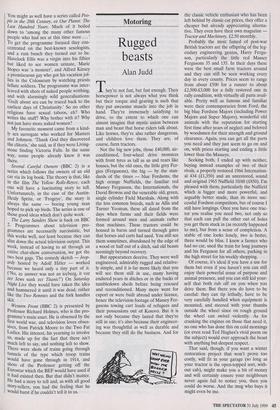Motoring
Rugged beasts
Alan Judd
They're not fast, but fast enough. Their horsepower is not always what you think but their torque and gearing is such that they put awesome muscle into the job in hand. They're immensely satisfying to drive, to the extent to which one can almost imagine that mystic union between man and beast that horse riders talk about. Like horses, they're also rather dangerous, and children love them. They are, of course, farm tractors.
Not the big new jobs, those £40,000, air- conditioned, four-wheel drive monsters with front tyres as tall as us and rears like houses, but the old ones, the little grey Fer- gies (Fergusons), the big — by the stan- dards of the times — blue Fordsons, the high orange Nuffields, the familiar red Massey Fergusons, the Internationals, the David Browns and the venerable old, green, single cylinder Field Marshals. Along with the less common breeds, such as Allis and Turner Yeoman, these all dated from the days when farms and their fields were formed around men and animals rather than machines. These tractors could be housed in barns and turned through gates that horses and carts had used. You still see them sometimes, abandoned by the edge of a wood or half out of a ditch, sad old beasts seemingly beyond recovery.
But appearances deceive. They were well engineered, admirably rugged and relative- ly simple, and it is far more likely that you will see them still in use, many having endured years in ditches or in the backs of tumbledown sheds before being rescued and reconditioned. Many more went for export or were built abroad under licence, hence the television footage of Massey Fer- gusons towing cart loads of refugees and their possessions out of Kosovo. But it is not only because they lasted that they're still in use; it's also because their engineer- ing was thoughtful as well as durable and because they still do the business. And for the classic vehicle enthusiast who has been left behind by classic car prices, they offer a cheaper but already appreciating alterna- tive. They even have their own magazine Tractor and Machinery, £2.50 monthly.
Probably the most famed of post-war British tractors are the offspring of the leg- endary engineering genius, Harry Fergu- son, particularly the little red Massey Fergusons 35 and 135. In their days these were the best small farm tractors around and they can still be seen working every day in every county. Prices seem to range from about £500 for a runner to about £2,500-£3,000 for a fully restored one in rally condition, with virtually all parts avail- able. Pretty well as famous and familiar were their contemporaries from Ford, the big blue Fordson Majors (including Power Majors and Super Majors), wonderful old animals with the reputation for starting first time after years of neglect and beloved by woodsmen for their strength and ground clearance. Again, you can get all the parts you need and they just seem to go on and on, with prices starting and ending a little lower than the Masseys.
Seeking both, I ended up with neither, buying instead examples of two of their rivals, a properly restored 1966 Internation- al 434 (£1,350) and an unrestored, sound and original 1965 Nuffield 10/60 (€850). I'm pleased with them, particularly the Nuffield which is bigger and more powerful, and arguably better made, than its more suc- cessful Fordson competitors, but of course I still have longings. Once you have one trac- tor you realise you need two, not only so that each can pull the other out of holes you get them stuck in (as recently happened to me), but from a sense of completion. A stable of one looks lonely, two is better, three would be bliss. I knew a farmer who had no car, used the train for long journeys and his Ferguson for all others, parking in the high street for his weekly shopping.
Of course, it's ideal if you have a use for them but even if you haven't you can still enjoy their powerful sense of purpose and animal presence, and you can still kid your- self that both rub off on you when you drive them. But there you do have to be careful: they can tip lethally, have to be very carefully handled when equipment is mounted, and steered with your thumbs outside the wheel since on rough ground the wheel can swivel violently. As for cranking the engines on those that need it, no one who has done this on cold mornings (or even read Ted Hughes's vivid poem on the subject) would ever approach the beast with anything but deepest respect.
That said, though, if you want a winter restoration project that won't prove too costly, will fit in your garage (so long as your tractor is the open-topped sort, with- out cab), might make you a bit of money and will certainly ensure your neighbours never again fail to notice you, then you could do worse. And the mug who buys it might even be me.


























































 Previous page
Previous page